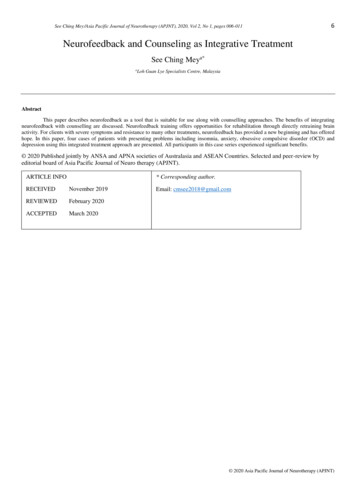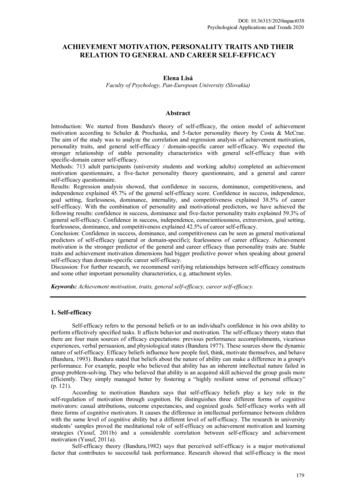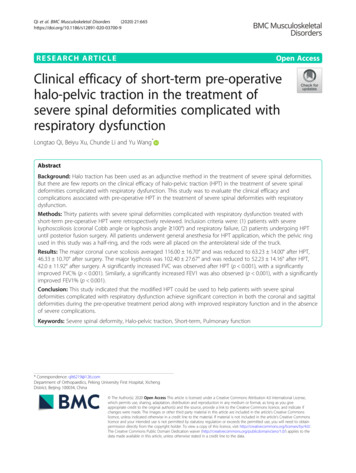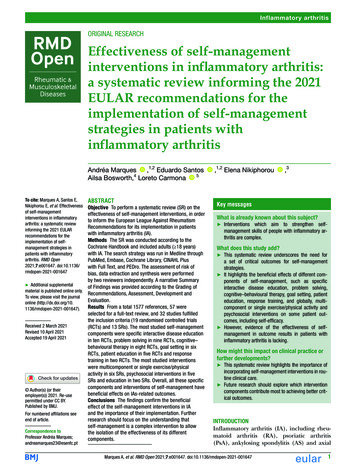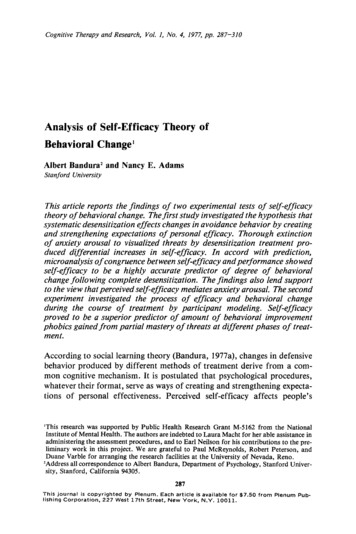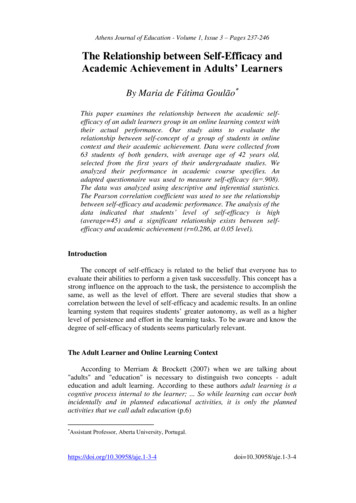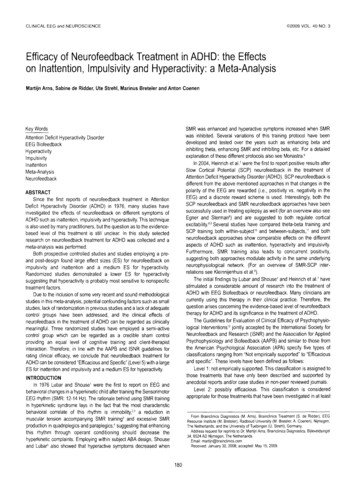
Transcription
02009 VOL. 40 NO. 3CLINICAL EEG and NEUROSCIENCEEfficacy of Neurofeedback Treatment in ADHD: the Effectson Inattention, Impulsivity and Hyperactivity: a Meta-AnalysisMartijn Arns, Sabine de Ridder, Ute Strehl, Marinus Breteler and Anton CoenenKey WordsSMR was enhanced and hyperactive symptoms increased when SMRwas inhibited. Several variations of this training protocol have beendeveloped and tested over the years such as enhancing beta andinhibiting theta, enhancing SMR and inhibiting beta, etc. For a detailedexplanation of these different protocols also see Monastra.6In 2004, Heinrich et al.7were the first to report positive results afterSlow Cortical Potential (SCP) neurofeedback in the treatment ofAttention Deficit Hyperactivity Disorder (ADHD). SCP neurofeedback isdifferent from the above mentioned approaches in that changes in thepolarity of the EEG are rewarded (i.e., positivity vs. negativity in theEEG) and a discrete reward scheme is used. Interestingly, both theSCP neurofeedback and SMR neurofeedback approaches have beensuccessfully used in treating epilepsy as well (for an overview also seeEgner and Steman') and are suggested to both regulate corticalex itability. . Several studies have compared theta-beta training andSCP training both within-subject1 and between-subjects," and bothneurofeedback approaches show comparable effects on the differentaspects of ADHD such as inattention, hyperactivity and impulsivity.Furthermore, SMR training also leads to concurrent positivity,suggesting both approaches modulate activity in the same underlyingneurophysiological network. (For an overview of SMR-SCP interrelations see Kleinnijenhuis et aL9).The initial findings by Lubar and Shouse' and Heinrich et aL7 havestimulated a considerable amount of research into the treatment ofADHD with EEG Biofeedback or neurofeedback. Many clinicians arecurrently using this therapy in their clinical practice. Therefore, thequestion arises concerning the evidence-based level of neurofeedbacktherapy for ADHD and its significance in the treatment of ADHD.The Guidelines for Evaluation of Clinical Efficacy of Psychophysiological Interventionst2 jointly accepted by the International Society forNeurofeedback and Research (ISNR) and the Association for AppliedPsychophysiology and Biofeedback (AAPB) and similar to those fromthe American Psychological Association (APA) specify five types ofclassifications ranging from "Not empirically supported" to "Efficaciousand specific". These levels have been defined as follows:Level 1: not empirically supported. This classification is assigned tothose treatments that have only been described and supported byanecdotal reports andlor case studies in non-peer reviewed journals.Level 2: possibly efficacious. This classification is consideredappropriate for those treatments that have been investigated in at leastAttention Deficit Hyperactivity DisorderEEG -AnalysisNeurofeedbackABSTRACTSince the first reports of neurofeedback treatment in AttentionDeficit Hyperactivity Disorder (ADHD) in 1976, many studies haveinvestigated the effects of neurofeedback on different symptoms ofADHD such as inattention, impulsivity and hyperactivity. This techniqueis also used by many practitioners, but the question as to the evidencebased level of this treatment is still unclear. In this study selectedresearch on neurofeedback treatment for ADHD was collected and ameta-analysis was performed.Both prospective controlled studies and studies employing a preand post-design found large effect sizes (ES) for neurofeedback onimpulsivity and inattention and a medium ES for hyperactivity.Randomized studies demonstrated a lower ES for hyperactivitysuggesting that hyperactivity is probably most sensitive to nonspecifictreatment factors.Due to the inclusion of some very recent and sound methodologicalstudies in this meta-analysis, potential confounding factors such as smallstudies, lack of randomizationin previous studies and a lack of adequatecontrol groups have been addressed, and the clinical effects ofneurofeedback in the treatment of ADHD can be regarded as clinicallymeaningful. Three randomized studies have employed a semi-activecontrol group which can be regarded as a credible sham controlproviding an equal level of cognitive training and client-therapistinteraction. Therefore, in line with the AAPB and ISNR guidelines forrating clinical efficacy, we conclude that neurofeedback treatment forADHD can be considered "Eficacious and Specific" (Level 5) with a largeES for inattention and impulsivity and a medium ES for hyperactivity.INTRODUCTIONIn 1976 Lubar and Shouse' were the first to report on EEG andbehavioralchanges in a hyperkinetic child after training the SensorimotorEEG rhythm (SMR: 12-14 Hz). The rationale behind using SMR trainingin hyperkinetic syndrome lays in the fact that the most characteristicbehavioral correlate of this rhythm is i m m b i l i t y ,a reduction inmuscular tension accompanying SMR training3 and excessive SMRproduction in quadriplegics and paraplegics: suggesting that enhancingthis rhythm through operant conditioning should decrease thehyperkinetic complaints. Employing within subject ABA design, Shouseand Lubar5 also showed that hyperactive symptoms decreased whenFrom Brainclinics Diagnostics (M A m ) , Brainclinics Treatment (S. de Ridder), EEGResource Institute (M. Breteler), Radboud University (M. Breteler, A. Coenen), Nijmegen.The Netherlands; and the University of Tuebingen (U.Strehl), Germany.Address request for reprints to Dr. Martijn Arns, Brainclinics Diagnostics. Bijleveldsingel34, 6524 AD Nijmegen, The NetherlandsEmail: martijn@brainclinics.comReceived. January 30,2008; accepted: May 15, 2003180
CLINICAL EEG and NEUROSCIENCE02009VOL 4 0 N 0 3hensive neurofeedback bibliography compiled by Hammondl6served asthe first basis. Furthermore, a search in PubMed was performed usingcombinations of the following keywords: "neurofeedback" or "EEGBiofeedback or "neurotherapy or "SCP" or "Slow Cortical Potentials"and "ADHD" or "ADD" or "Attention Deficit Hyperactivity Disorder" or"Attention Deficit Disorder." Furthermore, several authors were contactedwho had presented neurofeedback studies in ADHD on conferences(ISNR and Society for Applied Neuroscience (SAN)) during the last 2years to obtain potential studies that are currently in press.All these publications were obtained and screened for inclusioncriteria. The reference lists of the articles were also cross-checked forany missing studies. In order to guarantee sufficient scientific rigiditypapers had to be published in a peer-reviewed scientific journal or bepart of a PhD thesis.The designs had to comply with the following criteria: treated subjects should have a primary diagnosis of ADHDIADD; (1) controlled between subject design studies who have used a passive (waiting list) oractive (stimulant medication; biofeedback; cognitive training) controlgroups either randomized or not; or (2) prospective within subjectdesign studies or (3) retrospective within subject design studies with alarge enough sample to provide a reliable representation of dailypractice (N7500).The neurofeedback treatment was provided in a standardizedmanner, and no more than two treatment protocols were used.Standardized pre- and post-assessment means and StandardDeviations (SDs) for at least 1 of the following domains had to beavailable: Hyperactivity, Inattentiveness or CPT commission errorsWhen the means and SDs from a given study were not available, theywere requested from the authors. Not all authors responded or werestill able to retrieve this information, and if there was not sufficientinformation available the study was excluded from the meta-analysis.Study groupingIn neurofeedback training several treatment protocols are used, suchas SMR enhancement combined with Theta Suppression, Betaenhancement with Theta suppression, and the training of Slow CorticalPotentials (SCP). Most studies use central areas (Cz, C3, C4) as atraining site and only a few studies included Frontal sites (Fz, FCz). Toremain in line with the majority of the literature on EEG frequency bands,for this meta-analysis we classified both SMRflheta and BetalThetatraining as Betanheta training, since the SMR frequency band (12-15Hz) is part of the Beta-I frequency spectrum. Furthermore, as explainedin the Introduction both SCP and thetalbeta neurofeedback showcomparable effects on the different aspects ofADHD such as inattention,hyperactivity and impulsivity. Therefore, in the current meta-analysisboth SCP and theta-beta neurofeedback protocols are investigated inthe same analysis. The results from this meta-analysis will be reviewedpost-hoc for differential effects of the different training protocols.Data collectionThe following pre- and post-assessment measures were collectedfrom the included studies: (1) Hyperactivity: assessed with a DSMrating scale such as Conners (CPRS-R); ADDES-Home, BASC, SNAP,FBB-HKS (parents) or DSM-IV Rating Scale (Lauth and Schlottke); (2)Inattention: assessed with an inattention rating scale such as FBBHKS, Conners (CPRS-R, BASC, ADDES-Home, SNAPllowa-Conners)or DSM-IV Rating Scale (Lauth and Schlottke); (3) Impulsivity:commission errors on a CPT such as a TOVA, IVA (auditory prudencemeasure) or Go-NoGo test.These measures were used as treatment endpoints.one study that had sufficient statistical power, well identified outcomemeasures, but lacked randomized assignment to a control conditioninternal to the study.Level 3: probably efficacious. Treatment approaches that have beenevaluated and shown to produce beneficial effects in multiple observational studies, clinical studies, wait list control studies, and withinsubject and between-subject replication studies merit this classification.Level 4: efficacious. In order to be considered "efficacious," atreatment must meet the following criteria: (a) in a comparison with a notreatment control group, alternative treatment group, or sham (placebo)control utilizing randomized assignment, the investigational treatment isshown to be statistically significantly superior to the control condition orthe investigational treatment is equivalent to a treatment of establishedefficacy in a study with sufficient power to detect moderate differences;(b) the studies have been conducted with a population treated for aspecific problem, from whom inclusion criteria are delineated in areliable, operationally defined manner; (c) the study used valid andclearly specified outcome measures related to the problem beingtreated; (d) the data are subjected to appropriated data analysis; (e) thediagnostic and treatment variables and procedures are clearly defined ina manner that permits replication of the study by independentresearchers, and (f) the superiority or equivalence of the investigationaltreatment have been shown in at least two independent studies.Level 5: efficacious and specific. To meet the criteria for thisclassification, the treatment needs to be demonstrated to bestatistically superior to a credible sham therapy, pill, or bona fidetreatment in at least two independent studies.Monastra et a1.6 critically reviewed the literature and applied theabove mentioned guidelines. It was concluded that neurofeedbacktreatment for ADHD could be considered as "Level 3: probablyefficacious." However, in that same year Loo and Barkley13published areview article where they concluded that ".the promise of EEGBiofeedback as a legitimate treatment cannot be fulfilled without studiesthat are scientifically rigorous." ( 1 3 page 73). The main concerns theyraised were the lack of well controlled, randomized studies, the smallgroup sizes and the lack of proof that the EEG Feedback is solelyresponsible for the clinical benefit and not nonspecific factors such asthe additional time spent with a therapist or "cognitive training." In 2006,Holtmann and Stadtler14concluded that EEG Biofeedback has gainedpromising empirical support in recent years, but there is still a strongneed for more empirically and methodologically sound evaluationstudies. Given these different conclusions based on the same literature,a more quantitative approach might be warranted to establish theevidence-based level of neurofeedback treatment in ADHD alsoincluding more recent studies addressing some of the concerns raised.To date no quantitative meta-analysis has been done on this topic. Ameta-analysis provides a powerful approach to integrate many studiesand investigate the overall effect across studies. Such an analysis couldaddress some of the issues raised and test the effect size - and henceclinical relevance - of these methods in a quantitative manner. SinceADHD is characterized by persistent symptoms of inattention, impulsivityandlor hypera tivity' in this meta-analysis we will investigate the effectsof neurofeedback and stimulant medication on the core symptoms ofADHD: Hyperactivity, inattention and impulsivity.METHODStudy selectionThe literature was searched for studies investigating neurofeedbackor EEG Biofeedback in ADHD children. For this purpose the compre-181
CLINICAL EEG and NEUROSCIENCE02009 VOL. 40 NO. 3Meta-AnalysisIn a meta-analysis Effect Sizes (ES) are calculated based on thepre-treatment and post-treatment averages and standard deviationstaken from the studies included in the meta-analysis. This results in anES with a 95% confidence interval per study. An ES is a scale freestatistic, thus allowing comparison of scores on various instruments.Based on multiple studies a grand mean ES is calculated with a 95%confidence interval that provides the weighted ES for all studies whichcan be considered the true ES for the whole population. ES for thedifferent studies are often plotted in a forest plot providing a graphicaloverview of all results. The ES is regarded as a measure of "clinicalrelevance" in that the higher an ES the higher the clinical relevance.In this study, two ES were calculated. First, for the controlledbetween-subject design studies the ES of the neurofeedback group ascompared to the control group were calculated. These data were usedto compare the outcome after neurofeedback therapy with a controlcondition. Since some studies have used an active control group(Stimulant medication) or a semi-active control group (attentiontraining.'O l' EMG Biofeedback" or group-therapy'*) the within-subjectES were also calculated and plotted for all ADHD children treated withneurofeedback from both the controlled and the within-subject designs.ES were calculated with Hedges' D using the pooled pre-test SDlg20and the pre-post treatment differences for the outcome measures ofthe controlled studies. For the within-subject analysis the pre- andpost-treatment means and SDs were used to calculate the ES. Thegrand mean ES, 95% confidence intervals, Qt (heterogeneity of ES)and fail-safe number (Rosenthal's method: ac0.05) were calculatedusing MetaWin version 2.1." The fail-safe number is the number ofstudies, indicating how many unpublished null-findings are needed inorder to render an effect nonsignificant.When the total heterogeneity of a sample (at) was significant indicating that the variance among effect sizes is greater than expectedby sampling error - studies were omitted from the meta-analysis oneby-one, and the study contributing most to the significance of the Qtvalue was excluded from further analysis for that variable until the Qtvalue was no longer significant. This was done for a maximum of 3iterations. If more than 3 studies needed to be excluded in order toobtain a non-significant Qt value, then other explanatory variables forthe effects have to be assumed.z' In such a case the results for thatvariable will not be interpreted further.Post-Hoc AnalysisPost-hoc analyses were carried out to check for potentialdifferences in methodological approaches and quality of studies. TheES were submitted to a one-way ANOVA to analyse the followingvariables: (1) Neurofeedback protocol: SMRIBetaITheta vs.BetaiTheta vs. SCP protocols as well as SCP protocols vs. allBetaiTheta protocols; (2) Time: studies before 2006 and studies after2006 were compared to check for differences in ES in newer studies;(3) studies employing randomization vs. non-randomized studies.Since the a priori expectation is that randomized studies will havelower ES, we considered a p-value of below 0.1 as significant (onetailed significance) thus using a strict criterion for this dimension; (4)Medication: studies carried out in medicated subjects vs. studiescarried out in unmedicated subjects.Finally, the Pearson correlation coefficient was establishedbetween the average number of sessions and the ES. Since it isexpected from learning theory that more sessions will lead to betterclinical effects a one-tailed test was Derformed.RESULTSFifteen studies met all criteria and were included in the metaanalysis. One randomized controlled trial (RCT) from Linden etand one prospective study (Lubar et al.23)were excluded from themeta-analysis since no SDs were available for those studies. Twodouble-blind placebo controlled studies by deBeusZ4and PicardZ5andone controlled study by Fine, Goldman and SandfordZ6were excludedsince they were not published and no means and SDs were available.All studies investigated the effect of neurofeedback in children. Anoverview of all included studies can be found in Table 1. For all controlledstudies there was a total of 476 subjects, and for the prelpost-designstudies there was a total of 718 subjects included in the meta-analysis.D r o p a t rates were only reported in 5 t u d i e s and are ' -therefore notincluded in Table 1, Reported drop-out rates were around 10% for moststudies for both treatment and control groups.The following calculations were performed to make data compatiblewith the meta-analysis: Kropotov et al.31reported the data based on agroup of good-performers (N.71) and a group of poor performers(N.15). Xiong et al.32reported the data based for 3 groups of ADHD(Inattentive, Hyperactive and Combined type of ADHD). The means andSDs for these studies were hence re-calculated for the whole sampleusing the formula: SD sqrt[n'sum(xA2)-(sum(x))"2)/(n(n-l))] for standard deviations. All data used in this meta-analysis can be downloadedfrom www.brainclinics.com under downloads.Prospective controlled studiesNote that there were two types of controlled studies; studies with apassive or semi-active control group such as a waiting list controlgroup, EMG biofeedback and cognitive training and studies using anactive control group such as stimulant medication ("gold standard"treatment for ADHD). These studies have been analysed separately.Figure 1 shows the results of the meta-analysis for both the studieswith a passive control group (Neurofeedback vs. control group) and anactive control group (Neurofeedback vs. stimulant medication group).A positive ES denotes a decrease in symptoms for that measure. Forimpulsivity the ES for the neurofeedback vs. stimulant medicationgroup is close to 0; suggesting that neurofeedback has similar effectsas compared to stimulant medication. Furthermore, note the largegrand mean ES for inattention (ES 0.81) and impulsivity (ES 0.69) forneurofeedback compared to a control group. For hyperactivity andinattention there were not enough data available for a valid comparisonbetween methylphenidate and neurofeedbackInattentionThe test for heterogeneity was significant (Qt 43.47, p O.OOOO;mean ES: 0.9903) meaning that the variance among the ES wasgreater than expected by sampling error. It was found that the studyfrom Monastra et al.33 (ES.2.22) and Holtmann et al." (ES -0.39)contributed most to the significant Qt and were hence excluded fromthe analysis.The mean ES for inattention was 0.8097 (95% confidence interval(CI) 0.39-1.23; Total N.201). The test for heterogeneity was notsignificant (Qt 3.31, p 0.51). The fail-safe number of studies was 52.1,indicating that at least 52 unpublished null-findings are needed in orderto render the effect of neurofeedback on attention nonsignificantHyperactivityThe test for heterogeneity was significant (Qt l6.45, p 0.01153;mean ES: 0.6583). It was found that the study from Monastra et al.33(ES 1.36) contributed most to the significant Qt and was hence excluded from the analysis. The mean ES for hyperactivity was 0.3962182
2030USA27) Fuchs el al. 2003DEDE30) Strehl et al 200611) Leins et al 200719530'718ADHDADHDTotal N236017 39293 ulsivityInattentionMeasureczC3 or C8czC3 or C4CPz and CzCz orFCZ-CPZNF Site7c 3 - F or C4-PZczczTOVAc3, c 4DSM-IV RSC3f and C4fTAP: GO-NOGODSM-IV RSDSM-IV RSczTAP: GO-NOGODSM-IV SczTAP: tafThetaUnmedicatedBetafTheta1/19 MedicatedBeta (C3)SMR (C4)UnmedicatedBetairhelaUnmeditatedSCP5/23 MedicatedSCP and BetaKhetaUnmedicatedBetafrheta27/34 MedicatedSCP611 7 MedicatedBetafTheta411 8 MedicatedBetafr hetaUnmedicatedBetanheta6/31 MedicatedBetafrhetaUnmedicatedSCP8/13 MedicatedBetafThetaMedicatedBetanheta5/23 MedicatedTreatment.Mpnn.,- -, ,3030401720363030405025364320# Ses.Normalization of ERPsfor good-performersNormalization of FrontalNO-GON2 ERPDoehnert (2008):Post-QEEG: Thetadecreased at OzfMRl showed activation ofthe right ACcd, left caudateand lefi substantia nigraduring Counting Stroop testTCNV ERPOnly included sublects withincreased thetaibeta ratioLess cortical slowingNotesSCP Slow Cortical Potentials, SMR Sensorimotor EEG Rhythm, RCT Randomized Controlled Trial, DSM-IV RS DSM-IV Rating Scale (Lauth & Schlottke) * The original Kaiser 8 Othmersample consisted of 1089 subjects, however Means and SDs were only available for N 530 (Kaiser, personal communication )Pre-/post-designRandomized to SCPor BetaiThetaRETROSPECTIVE PRE-/POST-DESIGN STUDY34) Kaiser &USAMultisite naturalisticOthmer 2000pre-/postdesignPre-/post-designRandomized to SCPor BetaiThetaADHDADHDPre-/post-designChina32) Xiong et al 2005476Total CT Attentiontraining control groupRCTCaptain's Logcontrol groupGroup therapycontrol groupRCTControl groupEMG BiofeedbackADHD:Control:ADHD:Control:PROSPECTIVE PRE- / POST-DESIGN STUDIES31) KropotovRussiaPre-/post-designet al 2005DEDE10) Gevenslebenet al. 200917) Holtmannet al. 2009DE29) Bakhshayesh,2007CHCA35) Levesqueet al. 200618) Drechsler, 2007Stimulant controlgroupUSA28) Rossiter 2004RCTWaiting list controlWaiting list control7) Heinrich el al. 2004 DEQ'0"PStimulant 3) Monastraet al. 2002Control E CONTROLLED STUDIES40) Rossiter &Stimulant controlUSALa Vaque 1995groupTable 1This table shows an overview of all studies used in the meta-analysis. The study numbers correspond to the same numbers in the figures and the references.A total of 476 subjects were included based on prospective controlled studies and 718 subjects for studies employing a pre- post-test design.0(D0N0m02m0%5)Crn2aa,L?m
CLINICAL EEG and NEUROSCIENCE02009 VOL. 40 NO. 3--471,c m M.,"mIIISCP)7I .)15n INF n Icd*fion)M l N F n LLdrdml1-n (*1.W 1 C . h )GraM Maw ,N" 8 Halcol m,- mIlVlFWcmo4 - laJImpllslvlty ES (n-s2m,WDJFigure 1.This graph shows the forest plots for the controlled studies with the Effect Size (ES) and their 95% confidence intervals for controlled studies and numbers correspondto the studies in Table 1 The Grand Mean bars are the ES for inattention hyperactivity and impulsivity with the forest plot for impulsivity showing both the ES for neurofeedback compared to control groups (top grand mean) and neurofeedback compared to stimulant medication (bottom grand mean) A positive ES denotes a largerdecrease in symptoms for the neurofeedback group as compared to the control group It can be clearly seen from this figure that most studies had positive ES withGrand Mean ES medium to large and significantly different from zero Also note that the Grand Mean ES for the comparison of neurofeedback with stimulant medication IS almost 0 for impulsivity. indicating that these treatments have similar effects(95% CI 0.05-0.75; Total N.235. The test for heterogeneity was notsignificant (Qt 2.83, p 0.726). The fail-safe number of studies was 15.4.ImpulsivityNeurofeedback vs. Control GroupThe mean ES for impulsivity was 0.6862 (95% CI 0.34-1.03; TotalN.241). The test for heterogeneity was not significant (Qt 2.63,p 0.757). The fail-safe number of studies was 37.7.Neurofeedback vs. MethylphenidateThe mean ES for impulsivity was -0.0393 (95% CI -0.45-0.37; TotalN 240). The test for heterogeneity was not significant (Qt 0.26,p 0.967. The fail-safe number of studies was 0.Within-subject effectsIn Figure 2 the within-subject ES are shown for all studies includedin the meta-analysis. Note the high grand mean ES for all 3 domains.The study by Strehl et aL30and Leins et al." showed relatively low ESfor hyperactivity and inattention. This is probably caused by the DSMIV based questionnaire they used which only employs categoricalanswers (yesho) whereas all other studies used scales that employeddimensional scales.InattentionThe test for heterogeneity was significant (at-26.07, p 0.006;mean ES: 1.1126). It was found that the Monastra et al.33(ES-1.45))study contributed most to the significant Qt. This study combined aComprehensive Clinical Care plan with neurofeedback which mightpartly explain this finding. Furthermore, this study selected subjectsbased on an increased thetalbeta ratio and hence might not have beena representative ADHD group. This selection might have led to inclu-sion of a sub-group of ADHD patients which are good responders toneurofeedback, hence explaining the large ES.The mean ES for inattention after excluding this study was 1.0238(95% CI 0.84-1.21; Total N.324). The test for heterogeneity was notsignificant (Qt 16.26, p.0.093) meaning that the variance among theES was not greater than expected by sampling error. The fail-safe number of studies was 508.6.HyperactivityThe mean ES for hyperactivity was 0.7082 (95% CI 0.54-0.87; TotalN 375). The test for heterogeneity was not significant (at43.57,p 0.258) meaning that the variance among the ES was greater thanexpected by sampling error. The fail-safe number of studies was 320.3.ImpulsivityThe test for heterogeneity was significant (Qt 24.93, p 0.015;mean ES: 0.7487). It was found that the Kaiser and Othmer study%(ES 0.63) contributed most to the significant Qt. This was also the onlynaturalistic study; hence the ES was calculated excluding this study.The mean ES for impulsivity was 0.9394 (95% CI 0.76-1.12; TotalN 338). The test for heterogeneity was not significant (QP16.15,p 0.135) meaning that the variance among the ES was not greater thanexpected by sampling error. The fail-safe number of studies was 511.7.Figure 3 shows the grand mean ES for the controlled studiescompared to the within-subject ES for all studies for all 3 core symptoms. Note that ES for the controlled studies are slightly smaller,which could be due to the fact that many controlled studies used a"semi-active" control group such as attention training,'O," EMGB i f e e d b a c kor group-therapy.18 Furthermore, given the 95% con-184
02009 VOL. 40 NO. 3CLINICAL EEG and NEUROSCIENCEUm111.4aiG i l m Ucn,Ifl.4V1,481730 1 . 4Figure 2.This graph shows the forest plots for the within-subject ES for inattention (ES 1.02), hyperactivity (ES 0.71) and impulsivity (ES 0.94).All ES are shown with their95% confidence intervals and numbers correspond to the studies in Table 1. It can be clearly seen that all studies show positive ES and most are significant from 0given their 95% confidence intervals.lI oInattentionImpulsivityHyperactivityIFigure 3.This figure shows the grand mean ES for the controlled studies compared to the within-subject effect sizes for all studies for all 3 core symptoms. Note that the ES forthe controlled studies are slightly smaller, which could be due to the fact that many controlled studies used a "semi-active" control group. Furthermore, given the 95%confidence intervals the ES for inattention, hyperactivity and impulsivity are significant for both comparisons.185
CLINICAL EEG and NEUROSCIENCE02009 VOL. 40 NO. 32I1.8 -1.4-l’:.0.8.1.66kBP5 Hyperactivity.ImpulsivityAAp0.w;CJSpr0.6 0.4.0.2 011020I 30-I4050Number of sessionsFigure 4.This figure shows the correlation between number of sessions (horizontal) andthe ES (vertical) for the different studies. This figure shows the association forinattention (which was significant) and that there is an effect of a larger number of sessions.fidence intervals the ES for inattention, hyperactivity and impulsivityare significant for both comparisons.Post-hoc analysisPost-hoc analysis did not reveal any differences in ES betweenstudies 1) employing SMR/Theta, Betanhela, SMWBetaRheta andSCP neurofeedback protocols. Also no differences were foundbetween SCP studies on the one hand and all Betanhela studies onthe other hand and no effect was found for 2) Time. It can also be seenfrom the Forest plots that there is no clear relation between ES andtime. No significant differences were found between studies c
Deficit Hyperactivity Disorder (ADHD) in 1976, many studies have investigated the effects of neurofeedback on different symptoms of ADHD such as inattention, impulsivity and hyperactivity. This technique is also used by many practitioners, but the question as to the evidence- based level of this treatment is still unclear.
